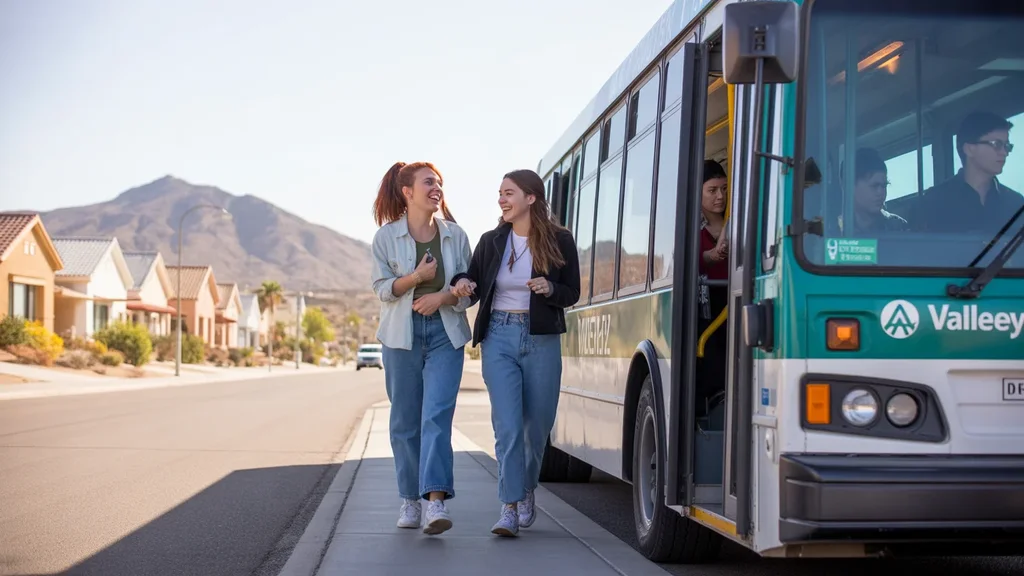What You’ll Spend on Transit in Buckeye
When budgeting for public transportation costs in Buckeye, expect to pay around $2.00 for a standard one-way bus fare in 2025. A 30-day bus pass in Buckeye typically costs $64. These prices are in line with average rates across midsize cities in Arizona and the greater Phoenix metro area.
While exact costs can vary based on age, disability status, and specific routes, these figures provide a reliable baseline for estimating your monthly transit expenses. Whether you’re a daily commuter or an occasional rider, understanding the fare structure is key to managing your budget effectively.
Transit Options Available

Buckeye’s public transportation system primarily consists of bus routes operated by Valley Metro, the regional transit authority serving the Phoenix metropolitan area. While light rail and commuter trains are available in some parts of the Valley, they do not currently extend to Buckeye.
The main transit options for Buckeye residents include:
- Local bus routes connecting key neighborhoods and destinations
- Express buses providing faster service to downtown Phoenix during peak commute times
- Paratransit services for riders with disabilities
Valley Metro buses generally run from early morning to late evening, with more limited service on weekends and holidays. Frequency varies by route, but most operate every 30-60 minutes.
Monthly Cost Breakdown
The total amount you’ll spend on public transit each month depends on your specific commuting needs and riding habits. Here’s a quick comparison of common scenarios:
| Rider Profile | Monthly Cost |
|---|---|
| 5-day weekly commuter | $80 (40 one-way trips) |
| Weekend-only rider | $32 (8 round trips) |
| Heavy daily user | $128 (2 one-way trips per day) |
🏆 Winner: For most Buckeye commuters, a standard 30-day bus pass offers the best overall value at $64 per month. If you ride at least 16 round trips (32 one-way fares), the pass more than pays for itself.
Is Public Transit Worth It in Buckeye?
Choosing between public transportation and driving often comes down to weighing cost, convenience, and personal preferences. The average bus commute in Buckeye takes around 45 minutes one-way, compared to a 25-30 minute drive.
However, riding the bus allows you to avoid traffic stress, parking fees, and vehicle wear-and-tear. If you live and work near major bus lines, using transit can be an economical alternative to car ownership – especially with today’s high gas prices.
Buckeye’s walkability is limited outside the city center, so you may still need a car for errands and off-peak trips. But if your daily routine aligns well with bus routes, public transit can help trim your monthly expenses significantly. Crunch the numbers using a monthly budget template for Buckeye households to see how the savings add up.
Ways to Save on Transit
Valley Metro and the City of Buckeye offer several discounted fare programs to help riders reduce their costs:
- Youth passes for riders ages 6-18
- Reduced fares for seniors 65+, people with disabilities, and Medicare cardholders
- Low-income assistance through the Valley Metro Reduced Fare ID program
Some employers also provide subsidized transit passes or pre-tax commuter benefits to encourage workers to use public transportation. Check with your company’s HR department to see if you qualify for any workplace incentives.
FAQs
What is the cheapest way to get around Buckeye?
Walking and biking are the most affordable transportation options in Buckeye, but may not be practical for longer trips. For motorized transport, the bus is generally cheapest, with fares starting at $2 per ride or $4 for an all-day pass.
Are there monthly transit passes in Buckeye?
Yes, Valley Metro offers a 30-day pass for $64 that provides unlimited rides on local buses and light rail. Reduced fare passes are available for youth, seniors, and riders with disabilities.
Is public transit reliable for work commutes?
While buses can be subject to traffic delays, Valley Metro works to maintain consistent service and schedules. Most riders find the system dependable for daily commuting, but it’s always wise to check route status and plan for extra time in case of unexpected slowdowns.
Getting Around Smarter in Buckeye
As Buckeye continues to grow, so do the options for affordable and eco-friendly transportation. By understanding the costs and trade-offs of public transit vs. private vehicles, you can make informed choices that fit your budget and lifestyle.
The next time you’re heading to work or exploring the city, consider hopping on a Valley Metro bus – it might just become your new favorite way to navigate Buckeye while keeping more cash in your pocket.
